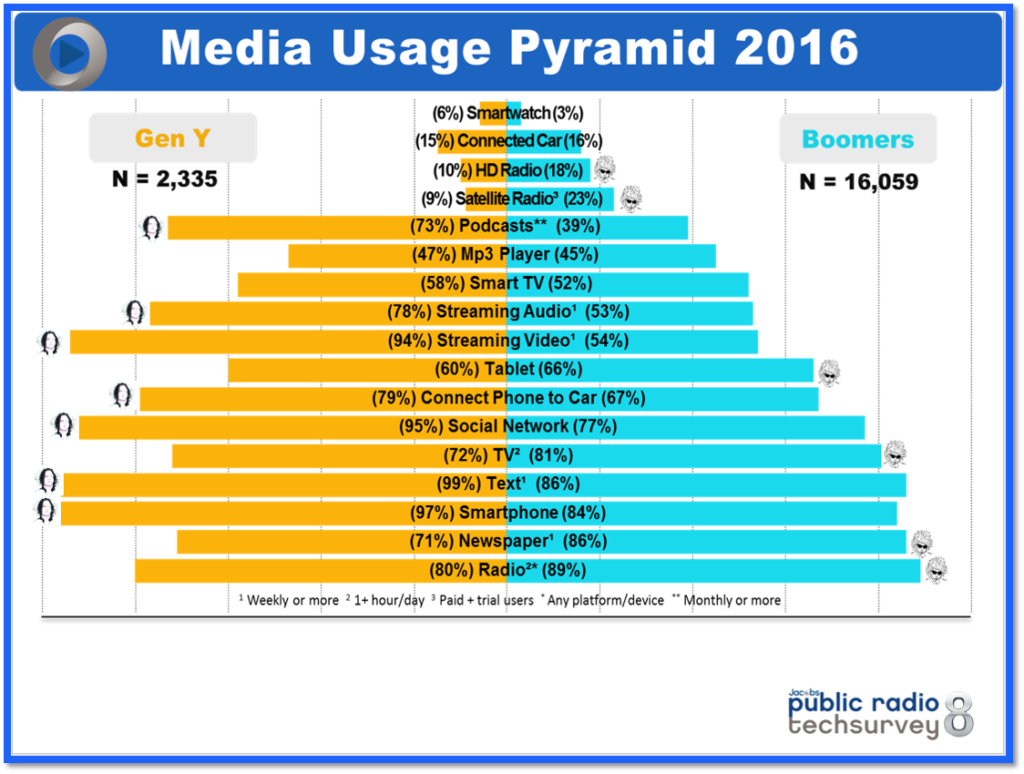
As we crisscross the country, moving from the Public Radio Program Directors convention in Phoenix to the NAB Radio Show in Nashville, there are some obvious contrasts between these two events.
But one common trait they share is an interest in Millennials – the biggest generation in the U.S., now eclipsing us Baby Boomers. Yet, there is no shortage of confusion and misconception about this often misunderstood group of young people.
In recent weeks, we’ve been involved with a new qualitative research study with PRPD, The Millennial Project. We’re conducting a series of one-on-one interviews, followed up by a dozen ethnographic “encounters” with members of Gen Y who listen to public radio.
And on the commercial radio side, we’re seeing more companies involve Millennials as well as members of Gen Z at the station level. Between the Conclave and Dan Vallie’s National Radio Talent System which holds institutes around the U.S., broadcasters are getting the message that Millennials need to be a viable part of radio if the industry is to remain vital.
But so many of these programs are predicated on older broadcasters mentoring Millennials – showing them the ropes, the way the “real world” works, the way we’ve always done it. Perhaps the unrealized benefit of having young people in the station is what they can teach us. Millennials are infinitely more immersed in new media and technology than their parents, and yet, workplace job hierarchy often takes precedence during a conversation about who should be schooling who.
I was reminded of this while putting together my Public Radio Techsurvey 8 presentation for PRPD this week. We built a dual Media Usage Pyramid, contrasting Millennials and Boomers. And the results are startling. On the Gen Y side you’ll see little Jack White icons symbolizing the media, gadgets, and activities more common to Millennials. And Boomers are represented by little Bob Dylan’s. Suffice it to say, these more mature public radio fans are simply more involved with traditional media – radio, TV, and newspapers, as well as satellite and HD Radio.
But among Millennials, the digital activities are the story: streaming, social media, and smartphones are so much more a part of their young lifestyles. And note the disparity with monthly usage of podcasts – one of the defining generational differences, and an important part of the public radio content and distribution strategy for the present and the future.

The human side of this dichotomy between Millennials and Boomers came through loud and clear in a recent New York Times story, “Reverse Mentoring,” by fiftysomething assignment editor Phyllis Korkki. Her story speaks volumes about the potential for grizzled veterans to get schooled by rookies, and the awkwardness that can ensue.
That may be counter-intuitive to some, but when Korkki turned to 27 year-old Talya Minsberg to learn how to design, build, and tell stories using Snapchat, the reverse mentoring process took flight. Korkki was simply afraid to dive into the deep social media side of the pool. Like so many Boomers who think that being on Facebook makes them knowledgeable about the social space, Korkki fought back her fears about learning something strange and new. And in the process, she turned to an expert in to learn the Snapchat ropes – a young social media specialist on the Times staff.
In most organizations – yes, even radio stations – there are Millennials engaged in many activities. Some are interns, others are sales assistants, and still others may hold part-time on-air or promotional support gigs.
But many have abilities that go beyond hanging banners at events or chasing coffee. They have skills that may elude the Xers and Boomers on the staff. It’s not just enough to just hire Millennials or even to mentor them. It takes courage to find out what they know, ask them questions, and tap into their skillsets.
The upside is that veteran staffers – especially in legacy businesss like print and radio – might learn how to shoot and edit video, use social outlets like Pinterest, Instagram, and Snapchat, or better understand what it is to create, record, and upload a podcast.
This idea of “Reverse Mentoring” may feel awkward at first. But as Korkki points out, learning how to tell a story on Snapchat “stretched me as a journalist and a person.”
We could all use a little of that.
Below is one of Korkki’s Snapchat stories:
- What Is It With Female Robot DJs? - April 30, 2025
- Why “Dance With Those Who Brung You” Should Be Radio’s Operating Philosophy In 2025 - April 29, 2025
- The Exponential Value of Nurturing Radio Superfans - April 28, 2025




Fred your reverse mentoring post is on the money. As a person who is now considered to be a”Senior Citizen”, I find that the millennials are interested in old school as much as I’m interested in ” new school”. The exchange of information has helped bridge the gap of understanding that creates stereotypes with the generations. We have to have dialog with the young people that have chosen terrestrial media as a career if it’s going to prosper in the future. It’s rapidly becoming their world and we have to trust them to make decisions just as those before us did with us. The rules are the same but the tools are better. We should learn how to use them to survive.
Spot on, Buzz. When I speak to college classes about life in the “real world,” I start out by grilling them – asking questions, testing theories, and doing my best to be a good listener. What an interesting time it is. Thanks for the comment.